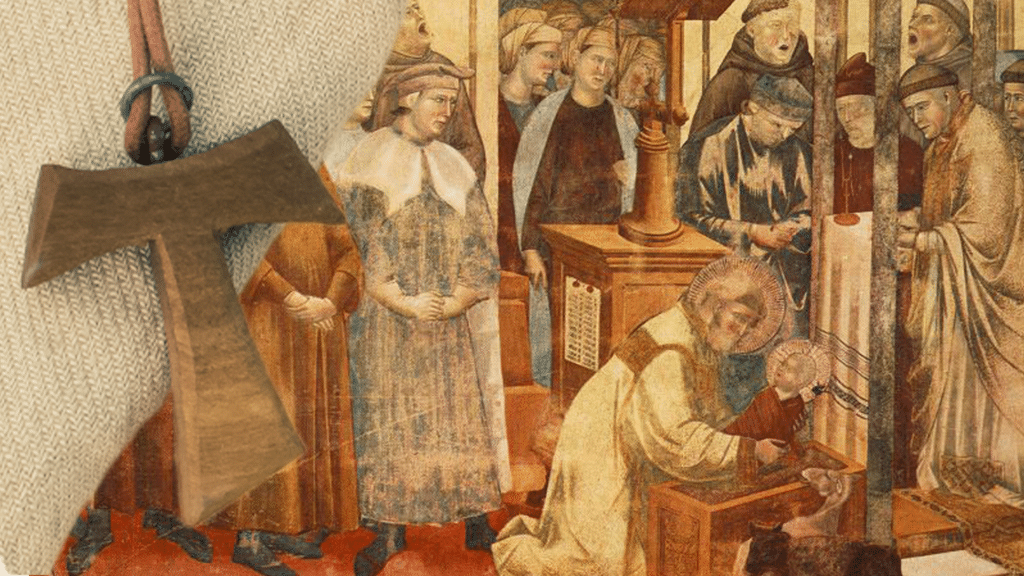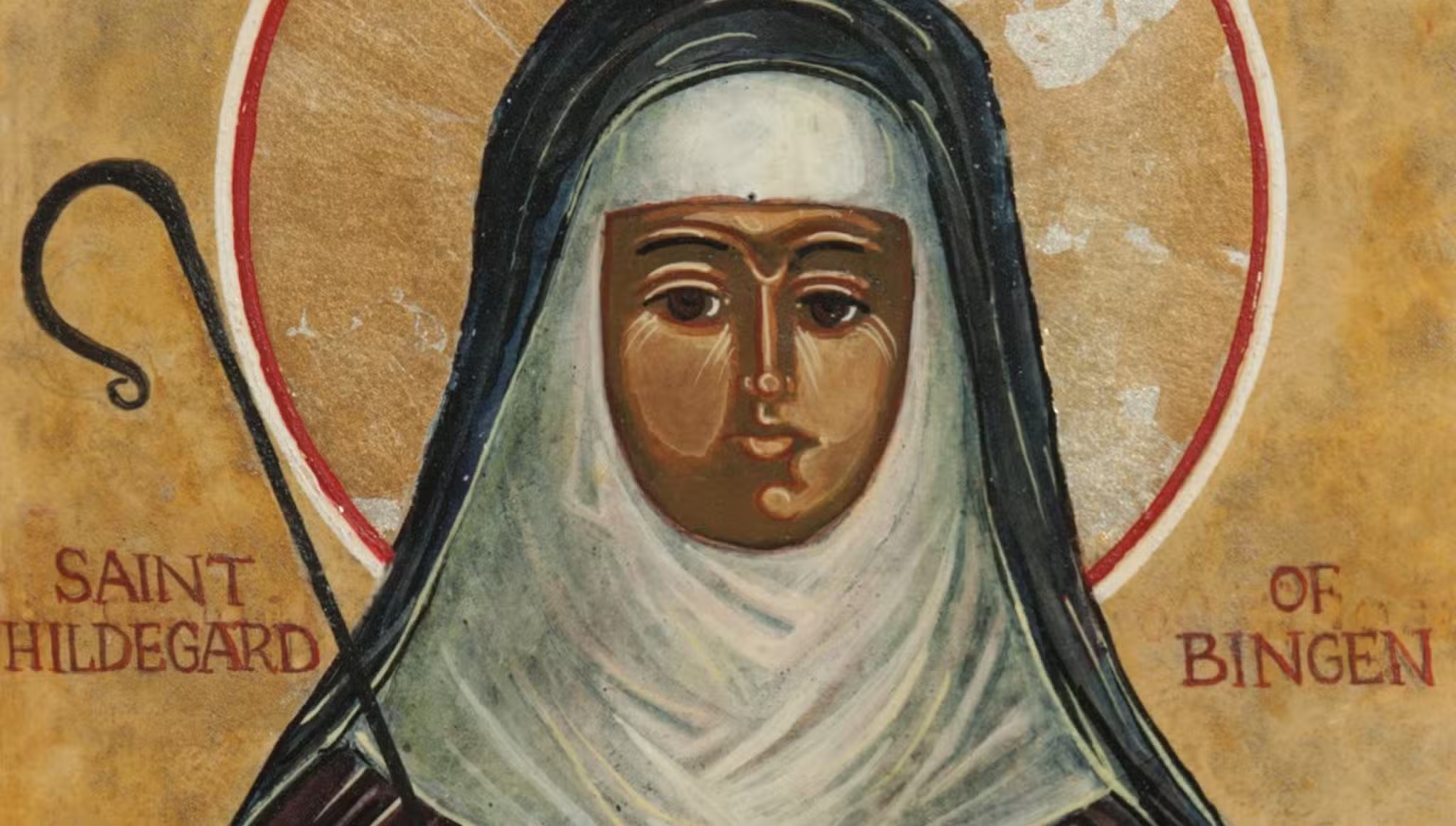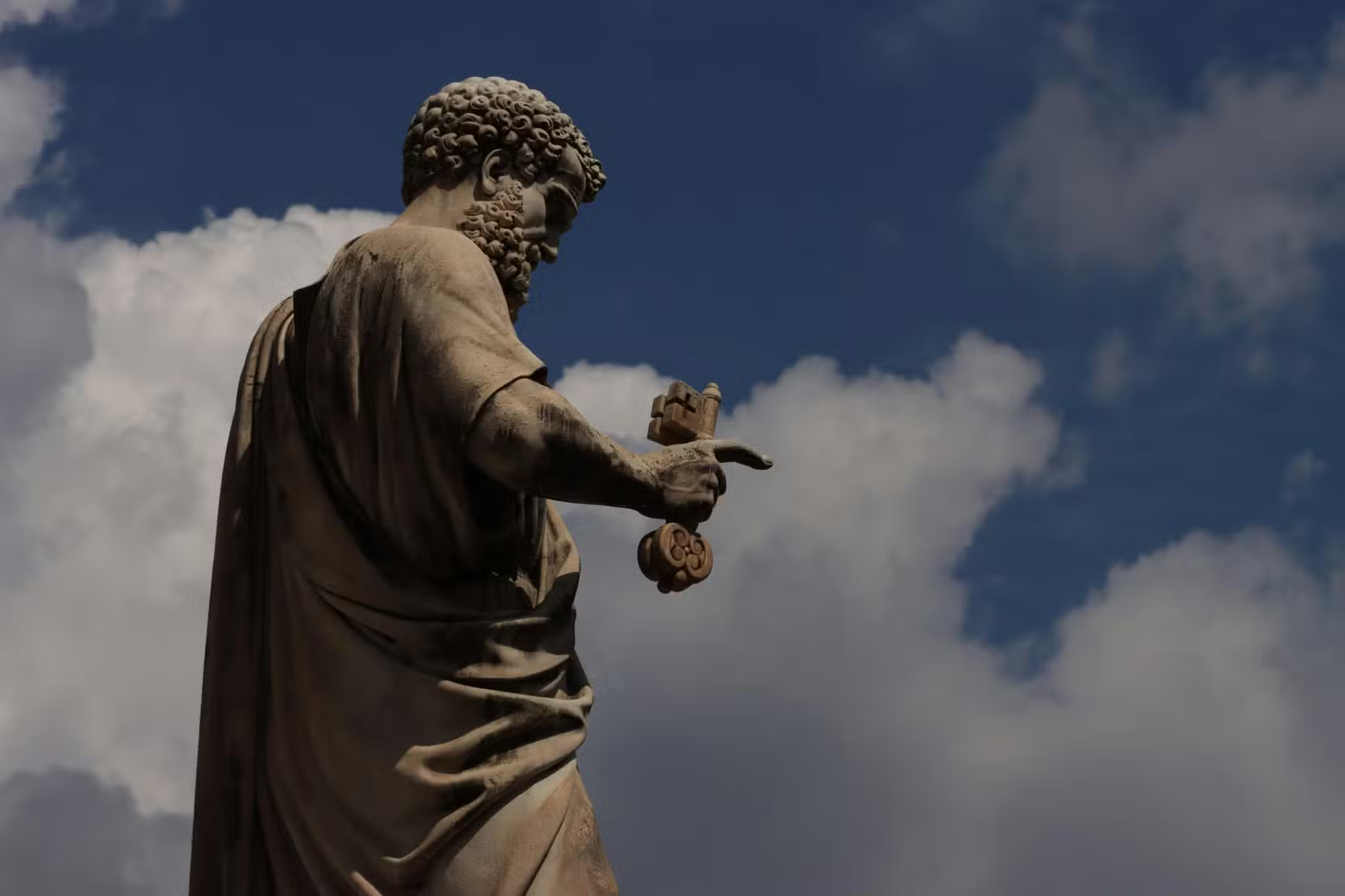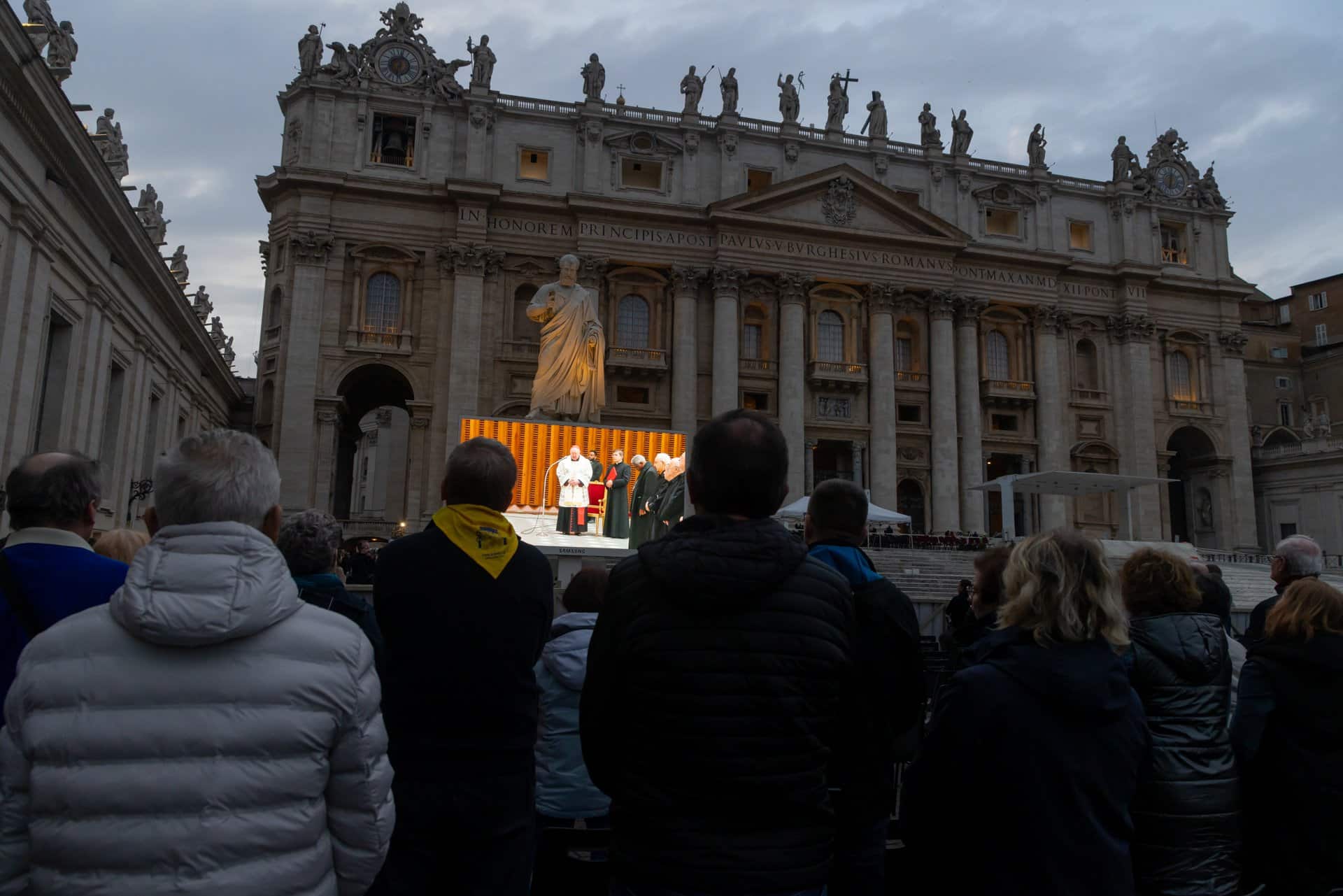Greccio and the O Antiphons
Preface
For centuries, friars in Greccio, Italy, have gathered their habits tight against the cold of December and scurried into the cave-like chapel for evening prayer. In the flickering of candlelight, encouraged by Brother Draft, a single voice would rise in pitch and confidence as if scaling the mountain itself. So, the O Antiphons would have been chanted and followed by a chorus of friars singing the Magnificat from the Gospel of Luke, Mary’s song of praise in response to the message of the Angel Gabriel:
My soul proclaims the greatness of the Lord, my spirit rejoices in God my Savior,
for he has looked with favor on his lowly servant.
From this day all generations will call me blessed:
the Almighty has done great things for me, and holy is his Name.
He has mercy on those who fear him in every generation.
He has shown the strength of his arm, he has scattered the proud in their conceit.
He has cast down the mighty from their thrones, and has lifted up the lowly.
He has filled the hungry with good things, and the rich he has sent away empty.
He has come to the help of his servant Israel for he has remembered his promise of mercy,
the promise he made to our fathers, to Abraham and his children forever.
Chanted during 17-23 December, the O Antiphons recall titles of Jesus, the Messiah, that have echoed from seashores to mountain tops and from synagogues to chapels since Old Testament times. Nestled within them, is a longing for the coming of Christ in glory, breathed afresh through the remembering of his first coming at Christmas.
- O Wisdom & O Lord of Israel – kindle within us a confidence in the will of God.
- O Root of Jesse & O Key of David – ground us in a hope of the promises we have made as the People of God.
- O Rising Dawn & O King of Nations – set our hearts on fire to live and proclaim the Good News.
- O Emmanuel, God with Us – draw us to live in the intimate presence of the Perfect Trinity and Simple Unity.
With a sense of humor later to be riveled by the Franciscans, a group of sixth-century monks arranged the O Antiphons in such a way that by working backwards from 23 December, the first letter of the Latin titles of Jesus [Emmanuel, Rex; Oriens, Clavis, Radix, Adonai, Sapientia] offer up a two-word phrase: ERO CRAS. Referring to Christmas Eve, this phrase translates, “I am coming tomorrow.” So, as the Messiah calls to us, may this book help us to ready ourselves for whenever tomorrow comes.
Introduction
Francis of Assisi is credited with popularizing the nativity scene with a live re-enactment at Greccio 800 years ago. In his 2019 Apostolic Letter Admirabile signum, Pope Francis reflects on Greccio in 1223, while considering the meaning and importance of the nativity scene. Channeling the spirit of Saint Francis, the Pope reminds us, “The nativity scene is like a living Gospel rising up from the pages of sacred Scripture. As we contemplate the Christmas story, we are invited to set out on a spiritual journey, drawn by the humility of the God who became human in order to encounter every man and woman. We come to realize that so great is his love for us that he became one of us, so that we in turn might become one with him.”[i]
This book is designed to help us make this spiritual journey of Advent and Christmas by bringing together both the inspiration of Greccio and the O Antiphons. In turn, these can help to assist us in our coming to a deeper consideration of how better to live the social teaching of the Church in our world today. In short, it is Franciscan “prayer in action” that strengthens our relationship with God and others, through moments of silence, movement, song, and reflection. Seeing through the eyes of his heart, Pope Francis tells us, “With the simplicity of that sign, Saint Francis carried out a great work of evangelization. His teaching touched the hearts of Christians and continues today to offer a simple yet authentic means of portraying the beauty of our faith. Indeed, the place where this first nativity scene was enacted expresses and evokes these sentiments. Greccio has become a refuge for the soul, a mountain fastness wrapped in silence.”[ii]
The prayer presented in this book, can be adapted for any context: from the kitchen of the overextended single-parent family to the chapel of a religious community. The setting up of the nativity scene can be done, for example, on the traditional “O Antiphon” days of 17-23 December, or it can also be done on any seven days during the Advent season. Let the Spirit lead you, and remember the advice of Pope Francis who says, “Standing before the Christmas crèche, we are reminded of the time when we were children, eagerly waiting to set it up. These memories make us all the more conscious of the precious gift received from those who passed on the faith to us. At the same time, they remind us of our duty to share this same experience with our children and our grandchildren. It does not matter how the nativity scene is arranged: it can always be the same or it can change from year to year. What matters is that it speaks to our lives. Wherever it is, and whatever form it takes, the Christmas crèche speaks to us of the love of God, the God who became a child in order to make us know how close he is to every man, woman and child, regardless of their condition.”[iii]
Each prayer begins with the O Antiphon of the day followed by the insights of Pope Francis on the meaning and importance of the nativity scene, as inspired by Saint Francis of Assisi at Greccio.[iv] Participants are then invited to arrange certain parts of the nativity scene, which can happen quickly or may take some time depending on the size of the nativity scene and one’s imagination. This is followed by the recommendation of the lighting of candles, progressing from one on the first day to seven on the final day. The lighting of the candle(s) might lead you to rest in a moment of silent gratitude to God. Then, you may choose to sing, once more, the verse of the song for each of the previous days, as candles are relit. Again, let the Spirit inspire your creativity. Finally, a passage from the social teaching of the Church is offered as a reflection that aims to bring the mysteries of the Christmas story into our world today and lead hopefully to some discussion. There is no formal ending offered. You could choose to offer spontaneous prayers of intercession or perhaps pray the Magnificat together (found in the Preface). The Spirit may lead you simply to transition to a cup of coffee or tea or hot chocolate and to a further conversation about the presence of Christ in your lives.
Day One: December 17
O Wisdom [O Sapientia]

Through Greccio, Pope Francis teaches us:
First, there is the background of a starry sky wrapped in the darkness and silence of night. Think now of all those times in our lives when we have experienced the darkness of night. Yet even then, God does not abandon us, but is there to answer our crucial questions about the meaning of life. Who am I? Where do I come from? Why was I born at this time in history? Why do I love? Why do I suffer? Why will I die? It was to answer these questions that God became human. His closeness brings light where there is darkness and shows the way to those dwelling in the shadow of suffering (cf. Lk 1:79).[v] In God’s Wisdom, a star is given for us to follow and in doing so we find the shining light of answers to the questions in the darkness of our hearts. The angels and the guiding star are a sign that we too are called to set out for the cave and to worship the Lord.
PLACE THE ANGELS AND THE STAR INTO THE NATIVITY SCENE
Light the First Candle & Sing:
O come O Wisdom from on high
Who orders all things mightily
To us the path of knowledge show
And teach us in your ways to go.
Rejoice! Rejoice! Emmanuel shall come to you O Israel.[ML1]
Living the Nativity Today:
As silence and careful listening disappear, replaced by a frenzy of texting, this basic structure of wise human communication is at risk. A new lifestyle is emerging, where we create only what we want and exclude all that we cannot control or know instantly and superficially. This process, by its intrinsic logic, blocks the kind of serene reflection that could lead us to a shared wisdom.
[Pope Francis, Fratelli Tutti 49]
Day Two: December 18
O Lord of Israel [O Adonai]

Through Greccio, Pope Francis teaches us:
On 25 December 1223, Saint Francis of Assisi and his friars came to Greccio from various parts, together with people from the farmsteads in the area, who brought flowers and torches to light up that holy night. When Francis arrived, he found a manger full of hay, an ox and a donkey. All those present experienced a new and indescribable joy in the presence of the Christmas scene. The priest then solemnly celebrated the Eucharist over the manger, showing the bond between the Incarnation of the Son of God and the Eucharist. At Greccio there were no statues; the nativity scene was enacted and experienced by all who were present. This is how our tradition began: with everyone gathered in joy around the cave, to worship the Lord with no distance between the original event and those sharing in its mystery.[vi]
PLACE THE HAY & THE ANIMALS INTO THE NATIVITY SCENE
Light Two Candles & Sing:
O come, O Come great Lord of might,
Who to Thy tribes on Sinai’s height
In ancient times did give the law
In cloud and majesty and awe.
Rejoice! Rejoice! Emmanuel shall come to you O Israel.
Living the Nativity Today:
Francis of Assisi helps us to see that an integral ecology calls for openness to categories which transcend the language of mathematics and biology, and take us to the heart of what it is to be human. Just as happens when we fall in love with someone, whenever he would gaze at the sun, the moon or the smallest of animals, he burst into song, drawing all other creatures into his praise. He communed with all creation, even preaching to the flowers, inviting them “to praise the Lord, just as if they were endowed with reason”. His response to the world around him was so much more than intellectual appreciation or economic calculus, for to him each and every creature was a sister united to him by bonds of affection.
[Pope Francis, Laudato Si’ 11]
Day Three: December 19
O Root of Jesse [O Radix Jesse]
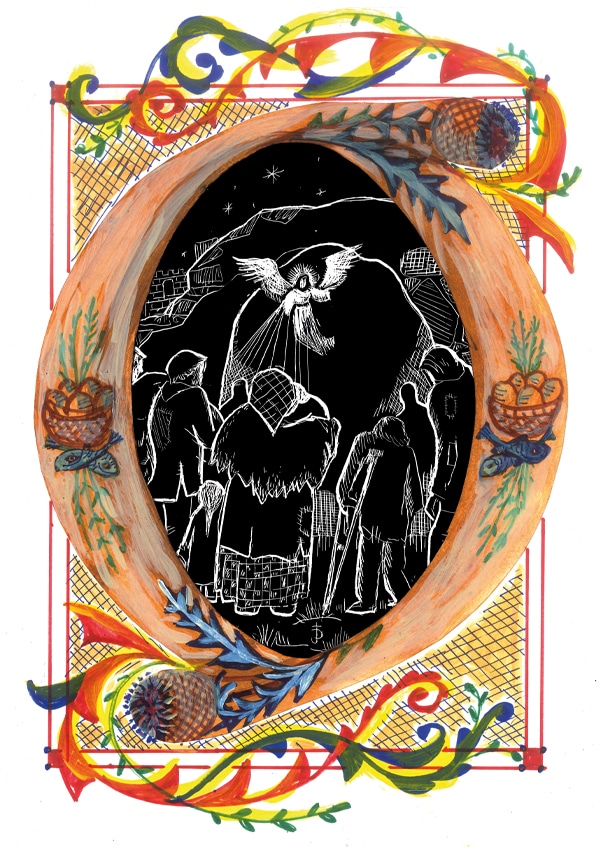
Through Greccio, Pope Francis teaches us:
It is customary to add many symbolic figures to our nativity scenes. First, there are the beggars and the others who know only the wealth of the heart. They too have every right to draw near to the Infant Jesus; no one can evict them or send them away from a crib so makeshift that the poor seem entirely at home. Indeed, the poor are a privileged part of this mystery; often they are the first to recognize God’s presence in our midst. The presence of the poor and the lowly in the nativity scene remind us that God became human for the sake of those who feel most in need of his love and who ask him to draw near to them. Jesus, “gentle and humble in heart” (Mt 11:29), was born in poverty and led a simple life in order to teach us to recognize what is essential and to act accordingly. By being born in a manger, God launches the only true revolution that can give hope and dignity to the disinherited and the outcast: the revolution of love, the revolution of tenderness. From the manger, Jesus proclaims, in a meek yet powerful way, the need for sharing with the poor as the path to a more human and fraternal world in which no one is excluded or marginalized.[vii]
PLACE THE FIGURES OF THE POOR AND VILLAGE PEOPLE INTO THE NATIVITY SCENE
Light Three Candles & Sing:
O come, Thou Root of Jesse’s tree,
An ensign of your people be;
Before Your rulers silent fall;
All people on your mercy call.
Rejoice! Rejoice! Emmanuel shall come to you O Israel.
Living the Nativity Today:
I invite everyone to renewed hope, for hope speaks to us of something deeply rooted in every human heart, independently of our circumstances and historical conditioning. Hope speaks to us of a thirst, an aspiration, a longing for a life of fulfillment, a desire to achieve great things, things that fill our heart and lift our spirit to lofty realities like truth, goodness and beauty, justice and love… Hope is bold; it can look beyond personal convenience, the petty securities and compensations which limit our horizon, and it can open us up to grand ideals that make life more beautiful and worthwhile. Let us continue, then, to advance along the paths of hope.
[Pope Francis, Fratelli Tutti 55]
Day Four: December 20
O Key of David [O Clavis David]
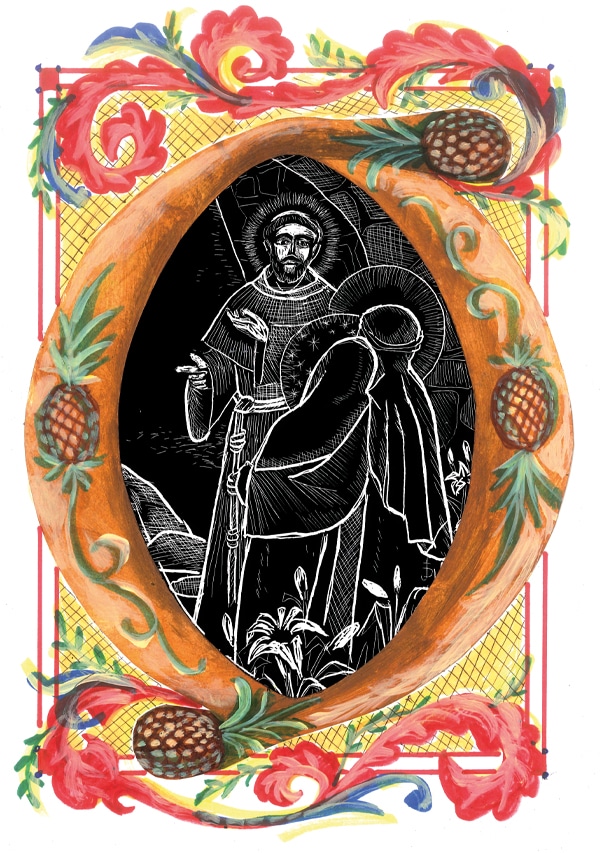
Through Greccio, Pope Francis teaches us:
Gradually, we come to the cave, where we find the figures of Mary and Joseph who had traveled to Bethlehem to be enrolled in the census, because they were of the House of David. Mary is a mother who contemplates her child and shows him to every visitor. The figure of Mary makes us reflect on the great mystery that surrounded this young woman when God knocked on the door of her heart. Mary responded to the message of the angel, “Behold I am the handmaid of the Lord; let it be to me according to your word” (Lk 1:38), showing all of us how to abandon ourselves in faith to God’s will. At Mary’s side, shown protecting the child and his mother, stands Saint Joseph, who tirelessly protects his family. When God warned him of Herod’s threat, he did not hesitate to set out and flee to Egypt (cf. Mt 2:13-15). Once the danger had passed, he brought the family back to Nazareth, where he was to be the first teacher of Jesus as a boy and then as a young man.[viii]
PLACE THE FIGURES OF MARY & JOSEPH INTO THE NATIVITY SCENE
Light Four Candles & Sing:
O come, Thou Key of David, come,
And open wide our heavenly home;
Make safe the way that leads on high,
And close the path to misery.
Rejoice! Rejoice! Emmanuel shall come to you O Israel.
Living the Nativity Today:
I would like to present Saint Joseph to you as a persecuted and courageous migrant. This is how the Evangelist Matthew describes him. This particular event in the life of Jesus, which also involves Joseph and Mary as protagonists, is traditionally known as “the flight into Egypt” (cf. Mt 2:13-23). The family of Nazareth suffered such humiliation and experienced first-hand the precariousness, fear and pain of having to leave their homeland. Still today many of our brothers and sisters are forced to experience the same injustice and suffering. The cause is almost always the arrogance and violence of the powerful. This was also the case for Jesus… Let us think of Jesus in the arms of Joseph and Mary, fleeing, and let us see in him each one of the migrants of today. Migration today is a reality to which we cannot close our eyes.
[Pope Francis, Catechesis on Saint Joseph – 5]
Day Five: December 21
O Rising Dawn [O Oriens]
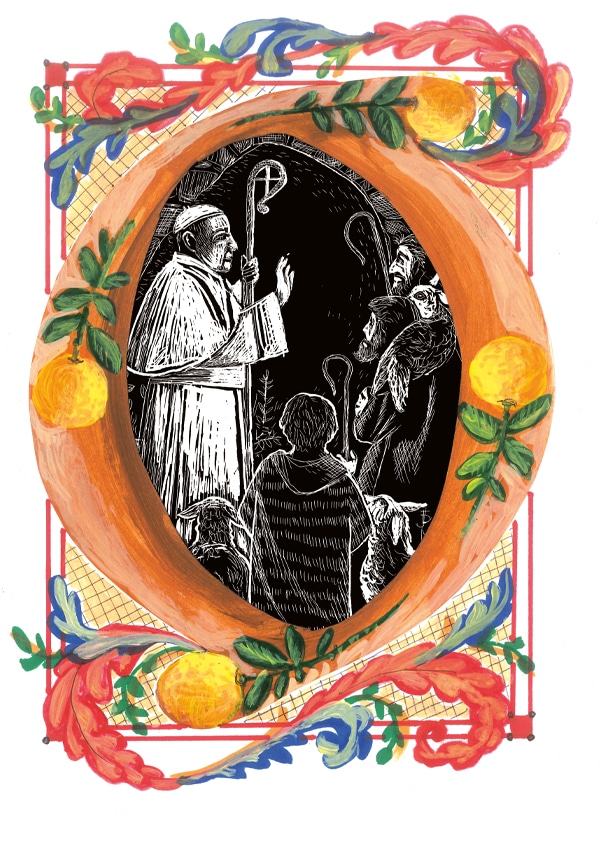
Through Greccio, Pope Francis teaches us:
In the Christmas Shepherd’s Mass celebrated in the rising dawn, we hear the exclamation, “Let us go over to Bethlehem and see this thing that has happened, which the Lord has made known to us” (Lk 2:15). So the shepherds tell one another after the proclamation of the angels. A beautiful lesson emerges from these simple words. Unlike so many other people, busy about many things, the shepherds become the first to see the most essential thing of all: the gift of salvation. It is the humble and the poor who greet the event of the Incarnation. The shepherds respond to God who comes to meet us in the Infant Jesus by setting out to meet him with love, gratitude and awe. Thanks to Jesus, this encounter between God and his children gives birth to our religion and accounts for its unique beauty, so wonderfully evident in the nativity scene.[ix]
PLACE THE FIGURES OF THE SHEPEHRDS INTO THE NATIVITY SCENE
Light Five Candles & Sing:
O come, Thou Dayspring, from on high,
And cheer us by Thy drawing nigh;
Disperse the gloomy clouds of night,
And death’s dark shadows put to flight.
Rejoice! Rejoice! Emmanuel shall come to you O Israel.
Living the Nativity Today:
The Church’s closeness to Jesus [the Dawn from on High who guides our feet into the way of peace] is part of a common journey; “communion and mission are profoundly interconnected”. In fidelity to the example of the Master, it is vitally important for the Church today to go forth and preach the Gospel to all: to all places, on all occasions, without hesitation, reluctance or fear. The joy of the Gospel is for all people: no one can be excluded. That is what the angel proclaimed to the shepherds in Bethlehem: “Be not afraid; for behold, I bring you good news of a great joy which will come to all the people (Lk 2:10). To understand this reality, we need to approach it with the gaze of the Good Shepherd, who seeks not to judge but to love.
[Pope Francis, Evangelii Gaudium 23 & 125]
Day Six: December 22
O King of Nations [O Rex Gentium]
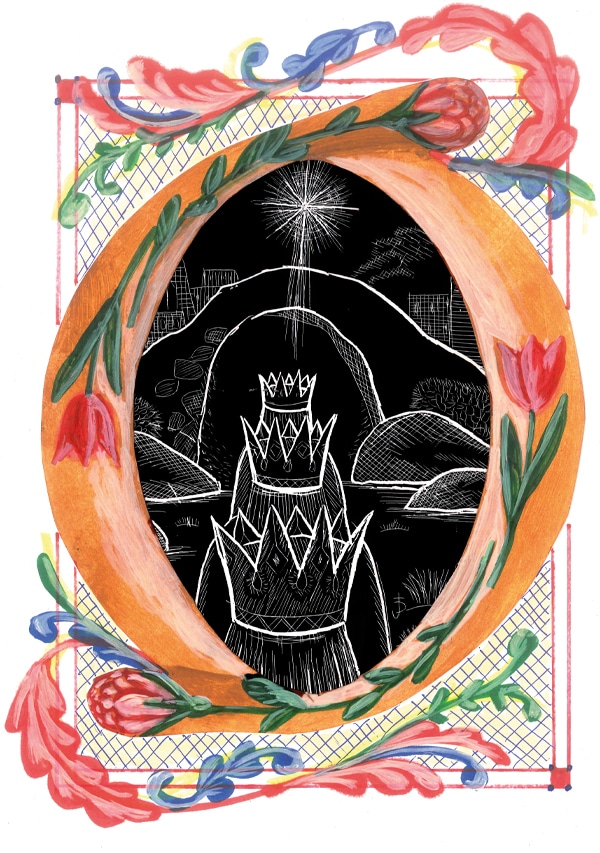
Through Greccio, Pope Francis teaches us:
Observing the star, those wise men from the Eastset out for Bethlehem, in order to find Jesus and to offer him their gifts of gold, frankincense and myrrh. These costly gifts have an allegorical meaning: gold honors Jesus’ kingship, incense his divinity, myrrh his sacred humanity that was to experience death and burial. The Magi teach us that people can come to Christ by a very long route. Men of wealth, sages from afar, athirst for the infinite, they set out on the long and perilous journey that would lead them to Bethlehem (cf. Mt 2:1-12). Great joy comes over them in the presence of the Infant King. They are not scandalized by the poor surroundings, but immediately fall to their knees to worship him. Kneeling before him, they understand that the God who with sovereign wisdom guides the course of the stars also guides the course of history, casting down the mighty and raising up the lowly.[x]
PLACE THE FIGURES OF THE KINGS INTO THE NATIVITY SCENE
Light Six Candles & Sing:
O come, Desire of nations, bind,
In one the hearts of all humankind;
Bid thou our sad divisions cease
And be thyself our King of Peace.
Rejoice! Rejoice! Emmanuel shall come to you O Israel.
Living the Nativity Today:
For the Church, the option for the poor is primarily a theological category rather than a cultural, sociological, political or philosophical one. God shows the poor “his first mercy”. This divine preference has consequences for the faith life of all Christians, since we are called to have “this mind… which was in Jesus Christ” (Phil 2:5). Inspired by this, the Church has made an option for the poor which is understood as a “special form of primacy in the exercise of Christian charity, to which the whole tradition of the Church bears witness… implicit in our Christian faith in a God who became poor for us, so as to enrich us with his poverty”. This is why I want a Church which is poor and for the poor. They have much to teach us.
[Pope Francis, Evangelii Gaudium 198]
Day Seven: December 23
O God with Us [O Emmanuel]
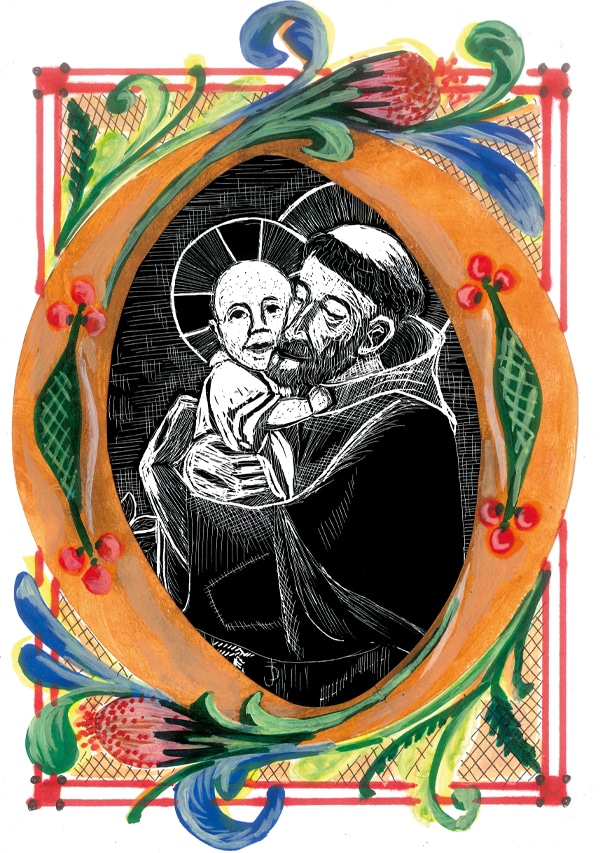
Through Greccio, Pope Francis teaches us:
When, at Christmas, we place the statue of the Infant Jesus in the manger, the nativity scene suddenly comes alive. God appears as a child, for us to take into our arms. Beneath weakness and frailty, he conceals his power that creates and transforms all things. It seems impossible, yet it is true: in Jesus, God was a child, and in this way, God wished to reveal the greatness of his love: by smiling and opening His arms to all. The birth of a child awakens joy and wonder; it sets before us the great mystery of life. Seeing the bright eyes of a young couple gazing at their newborn child, we can understand the feelings of Mary and Joseph who, as they looked at the Infant Jesus, sensed God’s presence in their lives. God’s ways are astonishing, for it seems impossible that he should forsake his glory to become a human like us. To our astonishment, we see God acting exactly as we do: he sleeps, takes milk from his mother, cries and plays like every other child! As always, God baffles us. He is unpredictable, constantly doing what we least expect. The nativity scene shows God as he came into our world, but it also makes us reflect on how our life is part of God’s own life. It invites us to become his disciples if we want to attain ultimate meaning in life.[xi]
PLACE BABY JESUS INTO THE NATIVITY SCENE
Light Seven Candles & Sing:
O come, O come Emmanuel,
And ransom captive Israel;
That mourns in lonely exile here,
Until the Son of God appear.
Rejoice! Rejoice! Emmanuel shall come to you O Israel.
Living the Nativity Today:
I invite all Christians, everywhere, at this very moment, to a renewed personal encounter with Jesus Christ, or at least an openness to letting him encounter them; I ask all of you to do this unfailingly each day. No one should think that this invitation is not meant for him or her, since “no one is excluded from the joy brought by the Lord”. The Lord does not disappoint those who take this risk; whenever we take a step towards Jesus, we come to realize that he is already there, waiting for us with open arms.
[Pope Francis, Evangelii Gaudium 3]
Conclusion
800 years ago, Saint Francis invited the people of Greccio to wander into a living nativity scene. In the same spirit we are called to enter our nativity scenes today. Making ourselves a part of the unfolding drama, we create a space to sing the song that the Christ Child has brought to birth in each of our hearts, as we worship our God, who became one like us that we might become like God and live forever.
When I was a little kid, our family nativity scene was as “a living Gospel rising up from the pages of sacred Scripture” in our home. In my mind’s eye Joseph still has a poorly painted beard and Mary continues to kneel beside the cradle, praying with bright red lips. I also remember who was missing from the scene. Noticeably absent was my favorite image of all the Christmas carols, the little drummer boy.[xii] So, when the house was quiet, under the twinkling lights of the tree, I would sit within the manger. Then, using my knees for a drum, I played and sang my song to Him, “Come they told me, pa-rum-pum-pum-pum…” Before I ever heard about “O Antiphons,” they reverberated on my “drum.”
May the “O Antiphons” become a part of your Christmas tradition. In time you may even come to imagine yourself holding the babe, while soothing Him with a song, “O Come, O Come…”
Then, within your heart, may you hear Him whisper back, “ERO CRAS, I am coming tomorrow.”
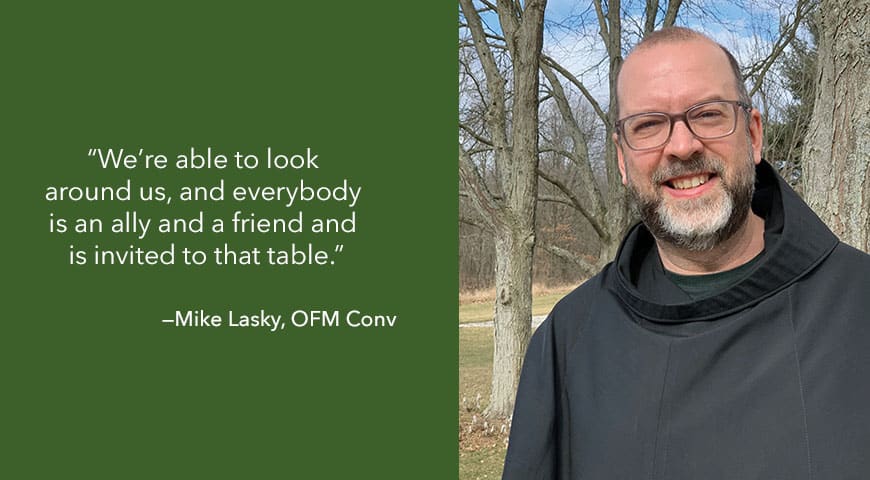
Contributor, Mike Lasky, OFM Conv
As the Chairman of the Justice, Peace and Integrity of Creation Commission worldwide, Father Michael uses his gifts for preaching and his generosity of spirit to live out the charism of St. Francis of Assisi. Based in Rome, Mike’s love for justice for all has no limitations; no matter what faith or cultural background ideals are held by those around him. He works to help educate, encourage, mediate and be an example of peace in our time.


